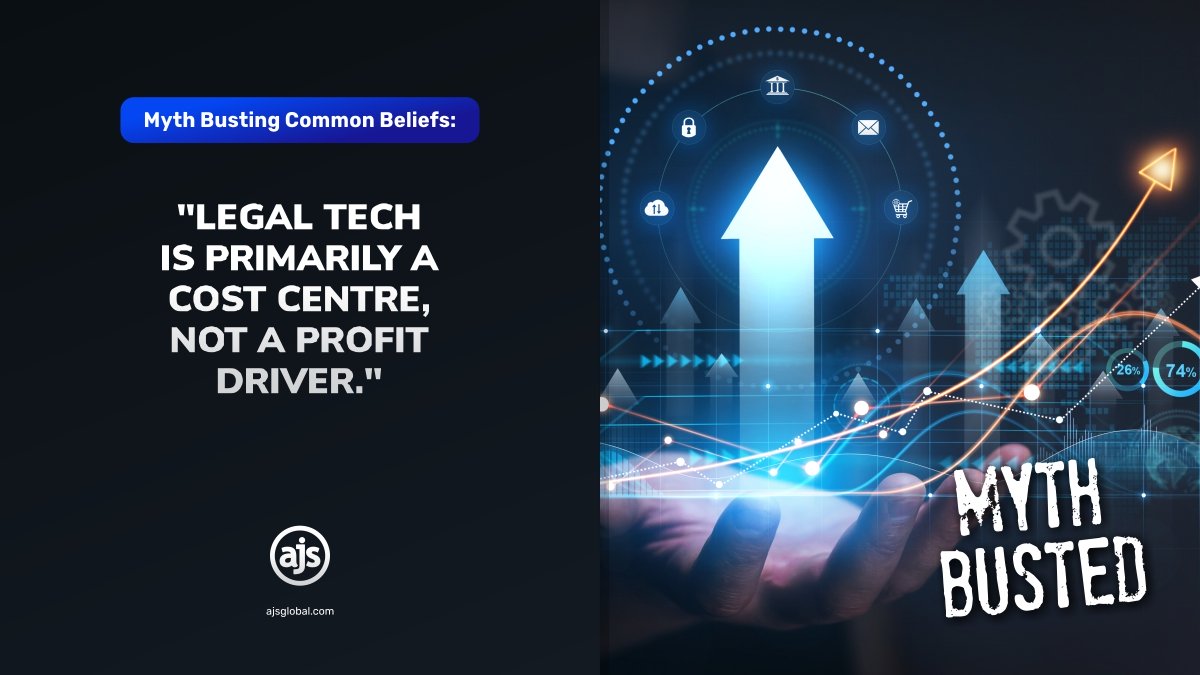
MYTH BUSTING COMMON BELIEFS: Part 9
Like “Legal tech is primarily a cost centre, not a profit driver.”
Businesses – in general – have often regarded the legal function as a corporate bottleneck and cost centre. And we have the lawyers themselves to thank for this viewpoint.
Harsh as it may sound, the legal culture, education, and “legalese” is just different than other corporate business units. Separate from it. And lawyers have long operated by their own rules, timelines, and metrics. Often even when they are corporate employees themselves. And the reason for this? Lawyers need to be separate from everyone else in order to maintain professional independence, freedom from economic conflict, and preservation of their ethical standards. It’s how lawyers essentially remain “unbiased” while employed as legal counsel.
Lawyers have constructed and zealously maintained a cultural, ethical, intellectual, philosophical, regulatory, economic, and educational trench that separates them from other professions, other business, and even society – the lawyer vs the layperson. And this lawyer vs layperson mindset has personified laws’ hubris and idea of being (excuse the pun) a “law unto themselves.”
Is it therefore a stretch to imagine that legal tech would be viewed in the same light? Seen as a separate and expensive cost? As a separate cost centre?
That leaves law firms, legal departments, and General Counsel in a rather interesting position. While they are not the ones driving the change, they are certainly the ones reacting to it – why? Because of the increasing pressure from clients, colleagues, and C-Suite that the legal function must join in the enterprises’ digital transformation journey.
And that requires legal, among other things, to align with the technological revolution we have all been involved in since COVID, the overarching corporate purpose, the need to start creating value, and the need to contribute to an elevated end-to-end customer experience – because (again) it’s what clients have come to expect.
An outdated misconception
Nowadays, viewing legal and indeed legal tech as a cost centre is a long-outdated misconception. And one that is shifting rapidly. Both because clients and corporates expect it, and also because it’s time to shift focus – law firm leaders and heads of department must start viewing legal tech and innovation as a direct revenue generator and not simply an operational function, especially if the ultimate goal is to successfully grow their businesses.
Because it’s now widely recognised that legal tech can and does function as a profit driver by increasing efficiency, enabling new service models, and creating new revenue streams. The distinction depends on how a firm or in-house department uses the technology.
Global Legal Post had this to say about the future of legal tech and how it can be viewed as a profit centre as opposed to a cost centre –
“The firms that succeed in today’s competitive environment are those that bridge these gaps, aligning innovation with business goals. When BD and innovation/legal tech work together, firms can move from pilots to profits: securing tangible ROI on rolling out new tools, building tech products that respond to client needs and reinforcing market differentiation. Additionally, when marketing joins the conversation at a strategic level, innovation becomes an essential part of the brand promise and the client experience.”
From the above, it’s clear that legal tech exists to enable the legal function to meet its challenges and to turn them into opportunity, thereby kick-starting the legal function’s transition from cost centre to value creator.
This is done by altering mindsets, automating, and enabling legal professionals to focus on higher-value tasks, and promoting integration with other business functions.
In other words, legal tech must go beyond simple cost-cutting and use technology to directly increase revenue and firm value.
Methods for driving profit
- Enhanced client experience – legal tech tools improve communication, transparency, and service delivery, leading to higher client satisfaction, loyalty, and the all-important word-of-mouth referrals. This is especially true for firms that adopt client portals and marketing automation tools.
- New business models – technology allows firms to offer new, tech-enabled services, like Chatbots that can answer questions at any time of the day or night. This includes moving from hourly billing to value-based or subscription models, which can provide more predictable revenue streams. Some firms develop their own tech solutions to offer to clients, creating a new line of business entirely.
- Market differentiation – utilising advanced legal tech, such as AI-driven legal research or bespoke client portals, can position a firm as innovative and modern, attracting new clients – especially from the Gen Z generation (the future clientele) and commanding higher fees.
- Expansion of services – technology allows firms to serve niche specialisations or expand their reach to new geographic areas and client segments, increasing their market share.
- Strategic intelligence – legal tech that captures data on case volume, billing trends, and client behaviour can provide insights to inform pricing models and business development strategy.
Legal tech as a cost centre
In a “cost centre” model, legal tech is treated as a necessary, but passive, expense to keep the business running. While this mindset is declining, many firms – unfortunately – still operate this way.
Factors supporting the cost centre view –
- Initial investment – the initial purchase and implementation of legal tech can be a significant upfront expense, which can deter firms – mostly because of how they incorrectly view the upfront expense – from adopting a profit-centric approach.
- Implementation costs – costs extend beyond the software itself to include staff training – except with AJS where you receive free online training – integrations with existing systems, and ongoing maintenance.
- Focus on efficiency, not growth – for a while now, legal tech’s primary purpose was to improve internal efficiency, not to generate revenue. The goal was simply to cut costs and automate routine tasks, not to transform the business model.
- Cultural resistance – many traditional law firms are slow to change and view technology as a tool for support staff, not as a driver of core legal services and revenue. But that mindset is slowly changing as lawyers themselves are seeing the upside of digitising their practice – they can upload documents from anywhere, bill fees from anywhere, they can automate reports, automate the drafting of basic documents. The benefits far outweigh any perceived resistances.
- Under utilisation – if legal tech tools are purchased but not integrated into the firm’s strategic goals or fully adopted by staff, they remain a sunk cost with limited return on investment. And that’s not ideal from wherever you sit.
The shift from cost to profit centre
This metamorphosis is happening right before our eyes. As firms move beyond seeing legal tech as a simple tool for automation and start using it for a competitive advantage, the whole perception of legal tech just as a cost centre changes. And this shift is propelled by –
- Mature AI – advancements in AI and machine learning allow for automation of more complex tasks, freeing up lawyers to focus on high-value, strategic work. In addition, lawyers have been given the opportunity to think outside the box and see where and how they might diversify should they have more time on their hands.
- Siloed integration – historically, innovation and business development teams operated separately. Now, firms are bridging this gap, with innovation teams working directly with business development and criss-crossing their way to including legal in decision making to create commercially viable products. It’s a real team effort with real cross collaboration across the board.
- Increased client demand – clients are demanding greater efficiency, transparency, and value from their legal service providers, pressuring firms to adopt legal tech that improves service delivery and offers more predictable pricing. Efficiency and efficacy are the names of the game now and both legal tech and now lawyers are rising to the challenge.
- Access to data – modern legal tech generates valuable business intelligence that allows firms to make more strategic decisions about resource allocation, pricing, and profitability. It’s big data. And it’s valuable. Both for internal strategic decision making as well as how they go about approaching the market.
It’s clear to see that a digitally fit-for-purpose legal function will elevate the profession, expand the role and impact of the legal function, it will create enterprise value, and it will improve the client experience. Legal professionals who use legal tech to its full potential will embrace new ways of working, will learn new skills, and will reap the rewards of the digital legal age.
It’s at this point that we think the answer to this conundrum is plain for all to see – the myth about legal tech being a mere cost centre and not a profit centre is BUSTED!
If you are in need of a service provider who has a proven track record or if you want to find out how to incorporate a new tool into your existing practice management suite – or if you simply want to get started with legal tech – feel free to get in touch with AJS. We have the right combination of systems, resources, and business partnerships to assist you with incorporating supportive legal technology into your practice. Effortlessly.
AJS is always here to help you, wherever and whenever possible!
– Written by Alicia Koch on behalf of AJS
(Sources used and to whom we owe thanks – OOOOOOO).





Leave a Reply